In a hot-water, or hydronic, heating system, water is heated in a gas, oil or electric boiler and circulated through pipes to radiators or their modern counterpart, convectors, located in the rooms. Radiators and con- vectors are designed with many fins, folds or tubes that add up to a large surface area, which allows them to give off considerable heat to the room. Various piping arrangements are used, as illustrated below.
A pump called a circulator drives the water through the pipes and convectors whenever the thermostat calls for heat. It’s usually positioned near the boiler in the return line; however, it’s better positioned on the supply line, pumping away from the expansion tank. This allows for a quieter system and fewer air-binding problems with the radiators and convectors. A flow- control valve keeps the water from flowing when the pump isn't operating; this keeps the system from overheating the convectors. Some older systems have no circulator but rely on the principle that water expands and becomes lighter when heated. The lighter hot water rises through the pipes and replaces the cooler, heavier water, which is pulled down through the return pipes by gravity.
Water expands when it's heated. Without room for expansion, pressure could build up rapidly, causing the safety relief valve to open. To prevent pressure buildup, an airtight expansion tank is installed near the boiler. As water in the system heats, it expands safely into the tank. If over time the expansion tank fills, excess water escapes through the safety relief valve on top of the boiler. Older types of tanks must be drained when they get too full of water; newer tanks have an elastic diaphragm separating the air from the water and should be drained only by a boiler specialist or plumber.
Improving efficiency. To reduce heat loss, insulate any pipes that run through crawl spaces or other unheated areas. To help balance heat throughout the house, adjust shutoff valves on individual radiators or convectors (no cost) or install separate thermostatic valves (more expensive).
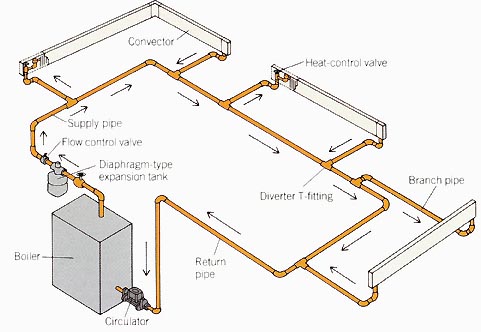
One-pipe system. In a one-pipe system, the supply pipe carries hot water past the convectors or radiators and back to the boiler. Convectors connect to the supply pipe by short branch pipes. When a convector’s heat-control valve opens, a special T-fitting diverts some water from the main line into the branch line. If a convector is shut off, hot water bypasses that branch and proceeds to the next one. The single-pipe system is most often used in small- and medium-size houses.

Two-pipe system. Best for large houses, this sys tem uses one pipe to carry hot water to convectors or radiators and another to return water to the boiler. Cooler return water flows through a separate pipe, not through the convectors, so the supply water remains hotter as it travels to the far ends of the system.
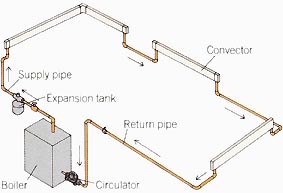
Series-loop system. In this simplest hot-water system, one pipe runs from the boiler through each convector or radiator (in one end, out the other) and back to the boiler in an uninterrupted loop. You can't turn off one convector in the loop without shutting them all off, but a system may have two or more loops.
continued....


Zoned Heating
To save energy, a hot-water system can be divided into zones. This lets you make occupied rooms warm while keeping others cooler. Typically, a two-zone system combines living areas, kitchen and bathrooms in one zone and bedrooms in another.
Zones are created by running branch lines off a main supply pipe to each desired zone and adding thermostatic zone valves in each branch to turn the hot- water supply on or off. One boiler and one circulator (or two of each in large houses) are used with multiple zone valves. Alternatively, a separate circulator can be used for each zone, eliminating zone valves.
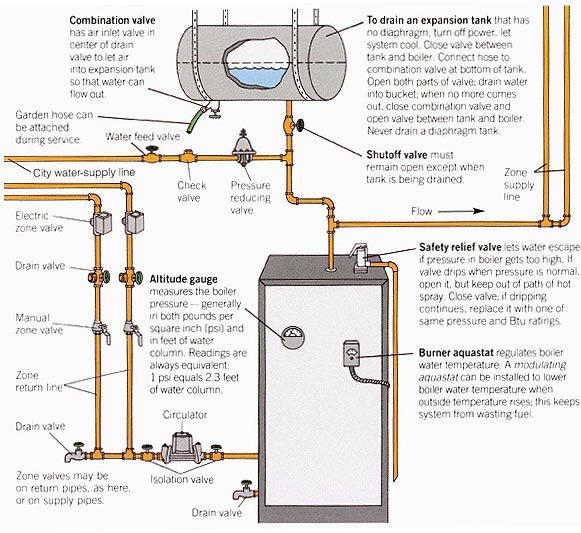
Combination valve has air inlet valve in center of drain valve to let air into expansion tank so that water can flow out.
To drain an expansion tank that has no diaphragm, turn off power, let system cool. Close valve between tank and boiler. Connect hose to combination valve at bottom of tank. Open both parts of valve; drain water into bucket; when no more comes out, close combination valve and open valve between tank and boiler. Never drain a diaphragm tank.
Shutoff valve must remain open except when tank is being drained.
Garden hose can be attached during service.
Safety relief valve lets water escape if pressure in boiler gets too high. If valve drips when pressure is normal. open it. but keep out of path of hot spray. Close valve; if dripping continues, replace it with one of same pressure and Btu ratings.
Burner aquastat regulates boiler water temperature. A modulating aquastat can be installed to lower boiler water temperature when outside temperature rises; this keeps system from wasting fuel.
Altitude gauge measures the boiler pressure generally in both pounds per square inch (psi) and in feet of water column. Readings are always equivalent: 1 psi equals 2.3 feet of water column.
Zone valves may be on return pipes, as here. or on supply pipes.
Electric zone valve, Drain valve, Manual zone valve, Zone return
line, Check valve, Pressure reducing valve, Zone supply line, Water
feed valve, Garden hose can be attached during service, Circulator,
Garden hose can be attached during service.
Venting a System
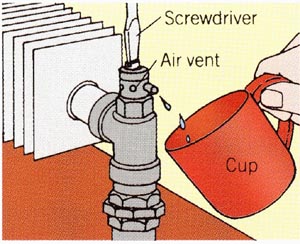
Trapped air prevents hot-water flow to a radiator or convector. Open an air vent (some require a special key) until water spurts out; catch it in a cup. Be careful, it’s hot! Start with the convector at the lowest level if more than one is cool.
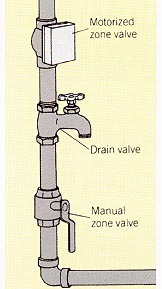
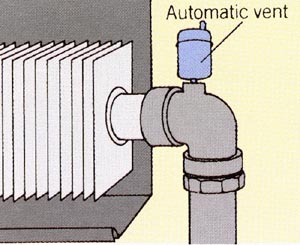
An automatic vent valve slowly releases air from a convector as the system fills with water ensuring good flow and even heat. The vent should be kept clean. If it drips water, replace it.
